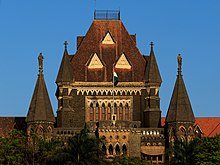Architecture of Maharashtra
architectural style of the state of Maharashtra and Maharashtrian people
(Redirected from Architecture of Mumbai)
Maharashtra state in India is known for its Famous caves and cliffs. It is said that the varieties found in Maharashtra are wider than the caves and rock-cut architecture found in the rock cut areas of Egypt, Assyria, Persia and Greece. The Buddhist monks first started these caves in the 2nd century BC, in search of serene and peaceful environment for meditation, and they found these caves on the hillsides.


Quotes
editArchitecture of Mumbai
edit- Bombay is energetic, exuberant, sparkling, and has building stones of many kinds and colours … on your dyspeptic days you are apt to find … Bombay's [architecture] bumptious, even riotous. In your more genial moments you might apply the adjective … 'vital'.
- John Begg, Consulting Architect to the City of Bombay, circa 1920. [citation needed]
- The first thing you notice about Mumbai is the first thing you notice about every place the British once occupied, which is how much of themselves they left there. The United States spent over a decade and trillions of dollars in Iraq, and the only physical evidence that remains is a concrete embassy compound, some airstrips, and a sea of steel shipping containers. Maybe because they never considered that they might leave, the British built entire cities out of stone, with railways to connect them. And they did it with reliably good taste. Too often lost in the hand-wringing over the evils of colonialism is the aesthetic contribution of the British Empire. The Brits tended to colonize beautiful places and make them prettier. Bermuda, New Zealand, Fiji, Cape Town—notice a theme? Style wasn’t an ancillary benefit; it was part of the point. Behind every Gurkha regiment marched a battalion of interior designers.
- Tucker Carlson, “Tucker Carlson's Diary: The Aesthetic Merits of British Colonialism" Spectator, March 3, 2016
- Nowhere is the architectural contrast starker and more jarring than in Mumbai. India is on its way to becoming a rich country, and Mumbai is its financial capital. Signs of wealth abound, from ubiquitous cranes to the mobile phones that every chai vendor carries. Fewer people seem to be living on the streets of downtown Mumbai than in midtown Manhattan. The good news is there’s a building boom under way. The bad news is, the results are appalling. Much of the new architecture is ugly, of course, straight from the Soviet-occupied-Poland school of design, but the construction is also shoddy. Buildings put up ten years ago are streaked with rust from exposed rebar, their concrete peeling apart in flakes. Even the newest blocks seem temporary or half-finished, as if nobody cared enough to complete the job. Not unlike post-invasion Baghdad, actually.
- Tucker Carlson, “Tucker Carlson's Diary: The Aesthetic Merits of British Colonialism" Spectator, March 3, 2016
- Meanwhile, at the south end of town, the Raj still dominates the skyline, and breathtakingly so. Is there a more attractive clock building outside Europe than the Rajabai Tower, completed in 1878? Does America have a single railway station that compares to the one Mumbai commuters have used since 1887? A single post office more impressive than the one the British built there in 1913? A more majestic municipal building than the Bombay High Court? The old section of Mumbai amounts to an open-air time capsule, substantially unchanged from the day Dickie and Edwina Mountbatten flew back to London. Unfortunately, nobody has cleaned up since. The old buildings are filthy and neglected, with broken shutters, missing windows, and front lawns piled with rubbish. Just a block or two from the Taj Mahal Hotel, near the ocean in one of the priciest parts of the city, there’s a row of wooden Victorian houses, large and ornate and beautiful. It looks like a postcard, but walk closer. The roofs have been patched with blue nylon tarps. The porches sag where the support beams have rotted. Each one verges on collapse. There’s something crushingly sad about all this, but also instructive. Empires end, usually more quickly than expected. They’re not always replaced by something better. Worth remembering at election time.
- Tucker Carlson, “Tucker Carlson's Diary: The Aesthetic Merits of British Colonialism" Spectator, March 3, 2016
- Architecturally, Bombay is one of the most appalling cities of either hemisphere. It had the misfortune to develop during what was, perhaps, the darkest period of all architectural history.
- Aldous Huxley, (1969). Jesting Pilate. The diary of a journey.
Architecture of Maharashtra
edit- The houses of this country (Maharashtra) are exceedingly strong and built solely of stone and iron. The hatchet-men of the Government in the course of my marching do not get sufficient strength and power (i.e., time) to destroy and raze the temples of the infidels that meet the eye on the way. You should appoint an orthodox inspector (darogha) who may afterwards destroy them at leisure and dig up their foundations.
- Maharashtra . Aurangzeb to Ruhullah Khan in Kalimat-i-Aurangzib. Kalimat-i-Aurangzeb, quoted in Sarkar, Jadu Nath, History of Aurangzeb,Volume III, Calcutta, 1972 Impression. p. 188-89 quoted in Shourie, Arun (2014). Eminent historians: Their technology, their line, their fraud. Noida, Uttar Pradesh, India : HarperCollins Publishers. [1]
- The Mosque of Qutb al-Din Mubarak Khalji at Daulatabad, dated AH 718/AD 1318, is probably the earliest surviving Muslim structure in the Deccan. It is a square, 260 feet each way, assembled into the usual orthodox plan out of destroyed Hindu pillars, brackets, and beams… It is said that the star-shaped Jaina Temple built in the Chalukya style at Bodhan in the 9th or 10th century was, also, transformed into a Mosque during the reign of Muhammad Tughlaq (AH 726-52/AD 1325-51)
- Maharashtra: Daulatabad and Bodhan. Syed Mahmudul Hasan, Mosque Architecture of Pre-Mughal Bengal, Dacca (Bangladesh), 1979, p. 50